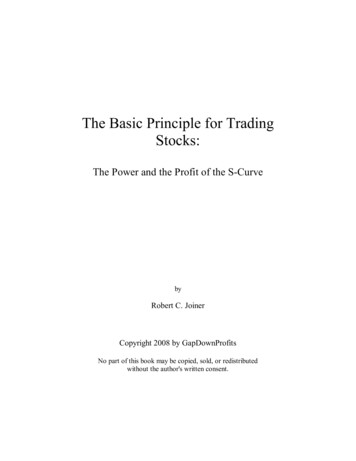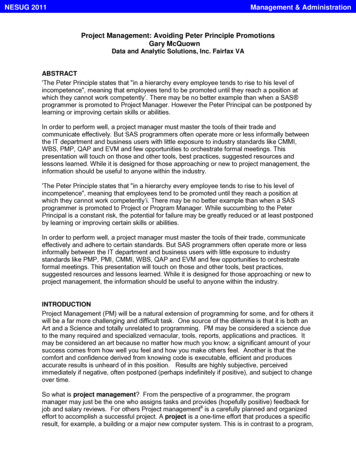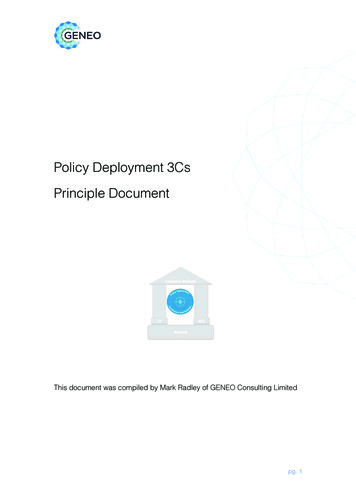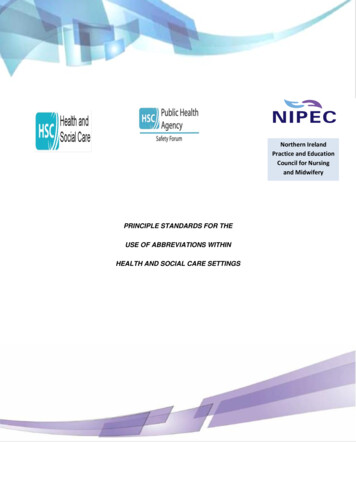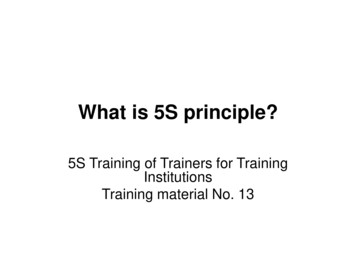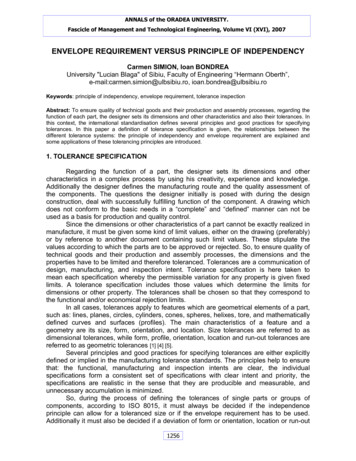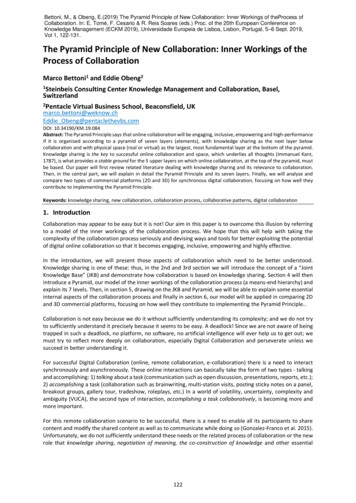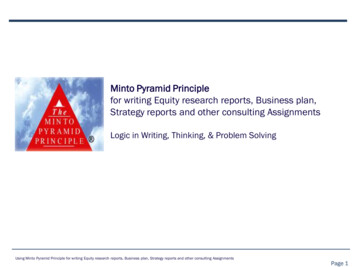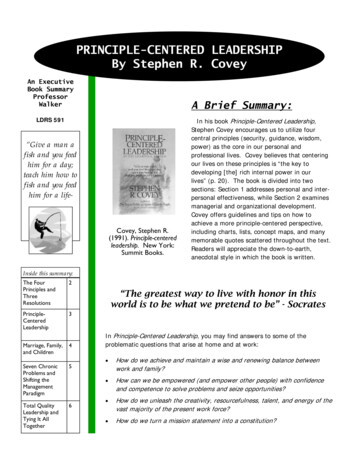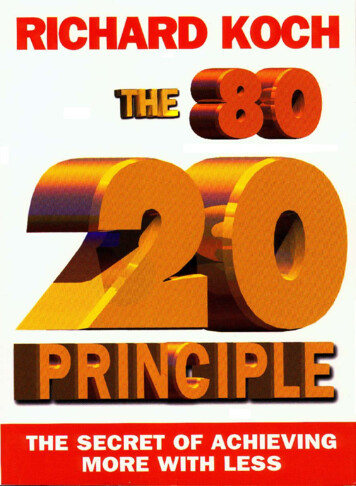
Transcription
Praise forThe 80/20 Principle‘Congratulations! The 80/20 Principle is terrific.’Al Ries, bestselling author of Focus and Positioning‘Koch is a passionate 80/20er. Read this and you will be too’.Andrew Campbell, Ashridge Strategic Management Centre‘Both astute and entertaining, this is an intriguing book tohelp people concentrate on not wasting their lives’.Professor Theodore Zeldin, St Anthony’s College, Oxford‘Through multiple examples, and a punchy down-to-earthcommentary, Koch offers the first really useful advice we’ve seen in amanagement book for years.’Business Age
The 80/20PrincipleThe Secret of AchievingMore with LessRichard KochNICHOLAS BREALEYPUBLISHINGLONDON
To LeeThis revised edition first published byNicholas Brealey Publishing Limited in 1998Reprinted 199836 John StreetLondonWC1N 2AT, UKTel: 44 (0) 171 430 0224Fax: 44 (0) 171 404 8311671 Clover DriveSanta RosaCalifornia 95401, USATel: (707) 566 8006Fax: (707) 566 8005http://www.nbrealey-books.comFirst published in hardback in 1997Reprinted (with corrections) 1997, 1998 Richard Koch 1997, 1998The right of Richard Koch to be identified as the author of this work has beenasserted in accordance with the Copyright, Designs and Patents Act 1988.ISBN 1-85788-167-2 HBISBN 1-85788-168-0 PBBritish Library Cataloguing in Publication DataA catalogue record for this book is available from theBritish Library.All rights reserved. No part of this publication may be reproduced, stored in aretrieval system, or transmitted, in any form or by any means, electronic, mechanical,photocopying, recording and/or otherwise without the prior written permissionof the publishers. This book may not be lent, resold, hired out or otherwise disposedof by way of trade in any form, binding or cover other than that in which it is published,without the prior consent of the publishers.Printed in Finland by Werner Soderstrom Oy.Although the author expresses a view on the likely future performance of certain investment instruments, this should not be taken as an incitement to deal in any of them, nor isit to be regarded as investment advice. Each individual should consider their investmentposition in relation to their own circumstances with the benefit of professional advice. Noresponsibility can be assumed by either the author or the publisher for investment or anyother decisions taken on the basis of views expressed in this book.Apart from any fair dealing for the purposes of research or private study, or criticism or review, as permitted under the relevant copyright,designs and patents acts, this publication may only be reproduced, stored or transmitted, in any form or by any means, with the priorpermission in writing of the publisher. eBooks Corporation
For a very long time, the Pareto law [the 80/20 Principle] haslumbered the economic scene like an erratic block on the landscape:an empirical law which nobody can explain.Josef SteindlGod plays dice with the Universe. But they’re loaded dice. And themain objective is to find out by what rules they were loaded and howwe can use them for our own ends.Joseph FordWe cannot be certain to what height the human species may aspire. . .We may therefore safely acquiesce in the pleasing conclusion thatevery age of the world has increased, and still increases, the realwealth, the happiness, the knowledge, and perhaps the virtue, of thehuman race.Edward Gibbon
ContentsRevised AcknowledgementsixPart One. Overture1Welcome to the 80/20 Principle2How to Think 80/20321Part Two. Corporate Success Needn’t Be a Mystery3The Underground Cult454Why Your Strategy is Wrong615Simple is Beautiful896Hooking the Right Customers1087The Top 10 Business Uses of the 80/20 Principle1248The Vital Few Give Success to You136
Part Three. Work Less, Earn and Enjoy More9Being Free14710Time Revolution15811You Can Always Get What You Want17912With a Little Help From Our Friends19113Intelligent and Lazy20414Money, Money, Money22415The Seven Habits of Happiness238Part Four: Crescendo16Progress Regained257Notes and References285Index299
RevisedAcknowledgementsThis has been the most painful and well-researched book I have everwritten. There is a certain irony here, since the 80/20 Principle tells us that Icould have obtained a book 80 per cent as good in 20 per cent of the time.This would certainly have been my inclination and only the reader can tellwhether the extra effort has been worthwhile. I think it has, but I have lostall objectivity. The effort involved has been much more collective than forany of my previous books. Don’t believe the false modesty of those whowrite generously that their books have been ‘team efforts’. In the end onlyan author (or authors) can write a book. But I want to thank someindividuals without whom this book would either not have existed or wouldhave been vastly inferior.First is Mark Allin, then at Pitman Publishing and now my partner inCapstone Publishing, who first had the idea of the book.Second is Nicholas Brealey. He has put terrific insight into the book. I amglad that the sales are rewarding this! According to the Von Mansteinprinciple (see Chapter 13), people like Nicholas who are smart andindustrious will not be as successful as those who are smart and lazy. Tobecome a real star, Nicholas must work a great deal less. I have a theory
that if he published half the number of books, and put all his effort intothese, he’d make even more money. I hope my next book will not be one toget the axe! I am very grateful for his persistence on this book.Sally Lansdell has been the ‘third person’ collaborating to get thestructure and text right. She is clearly a gifted publisher in her own right.Next, my researcher on the book, Nick Oosterlinck, did a terrific job ofreconstructing the history of the 80/20 Principle from 1897 to 1997. He hasnow disappeared from my radar screen, but if he would like to get in touch Iwould be delighted to dispense some champagne his way.I should also thank not only Mr Pareto for originating the 80/20 Principle,but also Mr Juran, Mr Zipf, Mr Krugman and the unsung heroes at IBM inthe 1960s for elaborating it. And also the hundreds of people from all walksof life and disciplines who have written magazine articles about the 80/20Principle, many of whom I have quoted extensively as evidence of the wayin which the principle can be used. I have made every effort to acknowledgethese people in the references, but if there are any omissions please acceptmy apologies and let me know so that correction can by made in any futureeditions. I am particularly grateful to David Parker, lecturer in managerialeconomics and business strategy at the University of Birmingham BusinessSchool, whose work on the application of chaos theory to business strategyis full of brilliant insights, many of which I have appropriated.Finally, every true believer needs his trusted sceptics. Patrick Weaver andLee Dempsey have fulfilled this role admirably, and it is much appreciated.Richard KochCape TownJanuary 1998
Part OneOverture
The universe is wonky!What is the 80/20 Principle? The 80/20 Principle tells us that in anypopulation, some things are likely to be much more important thanothers. A good benchmark or hypothesis is that 80 per cent of resultsor outputs flow from 20 per cent of causes, and sometimes from amuch smaller proportion of powerful forces.Everyday language is a good illustration. Sir Isaac Pitman, whoinvented shorthand, discovered that just 700 common words make uptwo-thirds of our conversation. Including the derivatives of thesewords, Pitman found that these words account for 80 per cent ofcommon speech. In this case, fewer than I per cent of words (the NewOxford Shorter Oxford English Dictionary lists over half a millionwords) are used 80 per cent of the time. We could call this an 80/1principle. Similarly, over 99 per cent of talk uses fewer than 20 percent of words: we could call this a 99/20 relationship.The movies illustrate the 80/20 Principle. A recent study shows that1.3 per cent of movies earn 80 per cent of box office revenues,producing virtually an 80/1 rule (see pages 17–18).The 80/20 Principle is not a magic formula. Sometimes therelationship between results and causes is closer to 70/30 than to80/20 or 80/1. But it is very rarely true that 50 per cent of causes leadto 50 per cent of results. The universe is predictably unbalanced. Fewthings really matter.Truly effective people and organizations batten on to the fewpowerful forces at work in their worlds and turn them to theiradvantage.Read on to find out how you can do the same . . .
1Welcome to the80/20 PrincipleFor a very long time, the Pareto law [the 80/20 Principle] has lumberedthe economic scene like an erratic block on the landscape; an empiricallaw which nobody can explain.Josef Steindl1The 80/20 Principle can and should be used by every intelligent person intheir daily life, by every organization, and by every social grouping andform of society. It can help individuals and groups achieve much more, withmuch less effort. The 80/20 Principle can raise personal effectiveness andhappiness. It can multiply the profitability of corporations and theeffectiveness of any organization. It even holds the key to raising the qualityand quantity of public services while cutting their cost. This book, the firstever on the 80/20 Principle, 2 is written from a burning conviction, validatedin personal and business experience, that this principle is one of the bestways of dealing with and transcending the pressures of modern life.
4OVERTUREWhat is the 80/20 Principle?The 80/20 Principle asserts that a minority of causes, inputs or effort usuallylead to a majority of the results, outputs or rewards. Taken literally, thismeans that, for example, 80 per cent of what you achieve in your job comesfrom 20 per cent of the time spent. Thus for all practical purposes, fourfifths of the effort—a dominant part of it—is largely irrelevant. This iscontrary to what people normally expect. So the 80/20 Principle states thatthere is an inbuilt imbalance between causes and results, inputs and outputs,and effort and reward. A good benchmark for this imbalance is provided bythe 80/20 relationship: a typical pattern will show that 80 per cent of outputsresult from 20 per cent of inputs; that 80 per cent of consequences flowfrom 20 per cent of causes; or that 80 per cent of results come from 20 percent of effort. Figure 1 shows these typical patterns.In business, many examples of the 80/20 Principle have been validated.20 per cent of products usually account for about 80 per cent of dollar salesvalue; so do 20 per cent of customers. 20 per cent of products or customersusually also account for about 80 per cent of an organization’s profits.In society, 20 per cent of criminals account for 80 per cent of the value ofall crime. 20 per cent of motorists cause 80 per cent of accidents. 20 percent of those who marry comprise 80 per cent of the divorce statistics (thosewho consistently remarry and redivorce distort the statistics and give alopsidedly pessimistic impression of the extent of marital fidelity). 20 percent of children attain 80 per cent of educational qualifications available.In the home, 20 per cent of your carpets are likely to get 80 per cent ofthe wear. 20 per cent of your clothes will be worn 80 per cent of the time.And if you have an intruder alarm, 80 per cent of the false alarms will be setoff by 20 per cent of the possible causes.The internal combustion engine is a great tribute to the 80/20 Principle.80 per cent of the energy is wasted in combustion and only 20 per cent getsto the wheels; this 20 per cent of the input generates 100 per cent of theoutput! 3
WELCOME TO THE 80/20 PRINCIPLEFigure 1. The 80/20 Principle5
6OVERTUREPareto’s discovery: systematic and predictablelack of balanceThe pattern underlying the 80/20 Principle was discovered in 1897, exactly100 years ago, by Italian economist Vilfredo Pareto (1848–1923). Hisdiscovery has since been called many names, including the Pareto Principle,the Pareto Law, the 80/20 Rule, the Principle of Least Effort and thePrinciple of Imbalance; throughout this book we will call it the 80/20Principle. By a subterranean process of influence on many importantachievers, especially business people, computer enthusiasts and qualityengineers, the 80/20 Principle has helped to shape the modern world. Yet ithas remained one of the great secrets of our time—and even the select bandof cognoscenti who know and use the 80/20 Principle only exploit a tinyproportion of its power.So what did Vilfredo Pareto discover? He happened to be looking atpatterns of wealth and income in nineteenth-century England. He found thatmost income and wealth went to a minority of the people in his samples.Perhaps there was nothing very surprising in this. But he also discoveredtwo other facts that he thought highly significant. One was that there was aconsistent mathematical relationship between the proportion of people (as apercentage of the total relevant population) and the amount of income orwealth that this group enjoyed.4 To simplify, if 20 per cent of the populationenjoyed 80 per cent of the wealth,5 then you could reliably predict that 10per cent would have, say, 65 per cent of the wealth, and 5 per cent wouldhave 50 per cent. The key point is not the percentages, but the fact that thedistribution of wealth across the population was predictably unbalanced.Pareto’s other finding, one that really excited him, was that this pattern ofimbalance was repeated consistently whenever he looked at data referring todifferent time periods or different countries. Whether he looked at Englandin earlier times, or whatever data were available from other countries in hisown time or earlier, he found the same pattern repeating itself, over andover again, with mathematical precision.Was this a freak coincidence, or something that had great importance
WELCOME TO THE 80/20 PRINCIPLE7for economics and society? Would it work if applied to sets of data relatingto things other than wealth or income? Pareto was a terrific innovator,because before him no one had looked at two related sets of data—in thiscase, the distribution of incomes or wealth, compared to the number ofincome earners or property owners—and compared percentages between thetwo sets of data. (Nowadays this method is commonplace, and has led tomajor breakthroughs in business and economics.)Sadly, although Pareto realized the importance and wide range of hisdiscovery, he was very bad at explaining it. He moved on to a series offascinating but rambling sociological theories, centring on the role of élites,which were hijacked at the end of his life by Mussolini’s fascists. Thesignificance of the 80/20 Principle lay dormant for a generation. While a6few economists, especially in the US, realized its importance, it was notuntil after the Second World War that two parallel yet completely differentpioneers began to make waves with the 80/20 Principle.1949: Zipf’s Principle of Least EffortOne of these pioneers was the Harvard professor of philology, George KZipf. In 1949 Zipf discovered the ‘Principle of Least Effort’, which wasactually a rediscovery and elaboration of Pareto’s principle. Zipf’s principlesaid that resources (people, goods, time, skills or anything else that isproductive) tended to arrange themselves so as to minimize work, so thatapproximately 20–30 per cent of any resource accounted for 70–80 per centof the activity related to that resource.7Professor Zipf used population statistics, books, philology and industrialbehaviour to show the consistent recurrence of this unbalanced pattern. Forexample, he analysed all the Philadelphia marriage licences granted in 1931in a 20-block area, demonstrating that 70 per cent of the marriages occurredbetween people who lived within 30 per cent of the distance.Incidentally, Zipf also provided a scientific justification for the messydesk for justifying clutter with another law: frequency of use draws near
8OVERTUREto us things that are frequently used. Intelligent secretaries have long knownthat files in frequent use should not be filed!1951: Juran’s Rule of the Vital Few and the rise of JapanThe other pioneer of the 80/20 Principle was the great quality guru,Romanian-born US engineer Joseph Moses Juran (born 1904), the manbehind the Quality Revolution of 1950–90. He made what he alternatelycalled the ‘Pareto Principle’ and the ‘Rule of the Vital Few’ virtuallysynonymous with the search for high product quality.In 1924, Juran joined Western Electric, the manufacturing division ofBell Telephone System, starting as a corporate industrial engineer and latersetting up as one of the world’s first quality consultants.His great idea was to use the 80/20 Principle, together with otherstatistical methods, to root out quality faults and improve the reliability andvalue of industrial and consumer goods. Juran’s path-breaking QualityControl Handbook was first published in 1951 and extolled the 80/20Principle in very broad terms:The economist Pareto found that wealth was non-uniformly distributed inthe same way [as Juran’s observations about quality losses]. Many otherinstances can be found—the distribution of crime amongst criminals, thedistribution of accidents among hazardous processes, etc. Pareto’sprinciple of unequal distribution applied to distribution of wealth and todistribution of quality losses.8No major US industrialist was interested in Juran’s theories. In 1953 he wasinvited to Japan to lecture, and met a receptive audience. He stayed on towork with several Japanese corporations, transforming the value and qualityof their consumer goods. It was only once the Japanese threat to USindustry had become apparent, after 1970, that Juran was taken seriously inthe West. He moved back to do for US industry what he had done for theJapanese. The 80/20 Principle was at the heart of this global qualityrevolution.
WELCOME TO THE 80/20 PRINCIPLE9From the 1960s to the 1990s: progress from using the80/20 PrincipleIBM was one of the earliest and most successful corporations to spot anduse the 80/20 Principle, which helps to explain why most computer systemsspecialists trained in the 1960s and 1970s are familiar with the idea.In 1963, IBM discovered that about 80 per cent of a computer’s time isspent executing about 20 per cent of the operating code. The companyimmediately rewrote its operating software to make the most used 20 percent very accessible and user friendly, thus making IBM computers moreefficient and faster than competitors’ machines for the majority ofapplications.Those who developed the personal computer and its software in the nextgeneration, such as Apple, Lotus and Microsoft, applied the 80/20 Principlewith even more gusto to make their machines cheaper and easier to use for anew tranche of customers, including the now celebrated ‘dummies’ whowould previously have given computers a very wide berth.Winner take allA century after Pareto, the implications of the 80/20 Principle have surfacedin a recent controversy over the astronomic and ever-rising incomes goingto superstars and those very few people at the top of a growing number ofprofessions. Film director Steven Spielberg earned 165 million in 1994.Joseph Jamial, the most highly paid trial lawyer, was paid 90 million.Merely competent film directors or lawyers, of course, earn a tiny fractionof these sums.The twentieth century has seen massive efforts to level incomes, butinequality, removed in one sphere, keeps popping up in another. In the USAfrom 1973 to 1995, average real incomes rose by 36 per cent, yet thecomparable figure for non-supervisory workers fell by 14 per cent. Duringthe 1980s, all of the gains went to the top 20 per cent of earners, and amind-boggling 64 per cent of the total increase went to the top
10OVERTURE1 per cent! The ownership of shares in the US is also heavily concentratedwithin a small minority of households: 5 per cent of US households ownabout 75 per cent of the household sector’s equity. A similar effect may beseen in the role of the dollar: almost 50 per cent of world trade is invoicedin dollars, far above America’s 13 per cent share of world exports. And,while the dollar’s share of foreign exchange reserves is 64 per cent, the ratioof American GDP to global output is just over 20 per cent. The 80/20Principle will always reassert itself, unless conscious, consistent andmassive efforts are made and sustained to overcome it.Why the 80/20 Principle is so importantThe reason that the 80/20 Principle is so valuable is that it iscounterintuitive. We tend to expect that all causes will have roughly thesame significance. That all customers are equally valuable. That every bit ofbusiness, every product and every dollar of sales revenue is as good asanother. That all employees in a particular category have roughly equivalentvalue. That each day or week or year we spend has the same significance.That all our friends have roughly equal value to us. That all enquiries orphone calls should be treated in the same way. That one university is asgood as another. That all problems have a large number of causes, so that itis not worth isolating a few key causes. That all opportunities are of roughlyequal value, so that we treat them all equally.We tend to assume that 50 per cent of causes or inputs will accountfor 50 per cent of results or outputs. There seems to be a natural, almostdemocratic, expectation that causes and results are generally equallybalanced. And, of course, sometimes they are. But this ‘50/50 fallacy’ isone of the most inaccurate and harmful, as well as the most deeply rooted,of our mental maps. The 80/20 Principle asserts that when two sets ofdata, relating to causes and results, can be examined and analysed, themost likely result is that there will be a pattern of
WELCOME TO THE 80/20 PRINCIPLE11imbalance. The imbalance may be 65/35, 70/30, 75/25, 80/20, 95/5, or99.9/0.1, or any set of numbers in between. However, the two numbers inthe comparison don’t have to add up to 100 (see page 23).The 80/20 Principle also asserts that when we know the true relationship,we are likely to be surprised at how unbalanced it is. Whatever the actuallevel of imbalance, it is likely to exceed our prior estimate. Executives maysuspect that some customers and some products are more profitable thanothers, but when the extent of the difference is proved, they are likely to besurprised and sometimes dumbfounded. Teachers may know that themajority of their disciplinary troubles or most truancy arises from aminority of pupils, but if records are analysed the extent of the imbalancewill probably be larger than expected. We may feel that some of our time ismore valuable than the rest, but if we measure inputs and outputs thedisparity can still stun us.Why should you care about the 80/20 Principle? Whether you realize it ornot, the principle applies to your life, to your social world and to the placewhere you work. Understanding the 80/20 Principle gives you great insightinto what is really happening in the world around you.The overriding message of this book is that our daily lives can be greatlyimproved by using the 80/20 Principle. Each individual can be moreeffective and happier. Each profit-seeking corporation can become verymuch more profitable. Each non-profit organization can also deliver muchmore useful outputs. Every government can ensure that its citizens benefitmuch more from its existence. For everyone and every institution, it ispossible to obtain much more that is of value, and avoid what has negativevalue, with much less input of effort, expense or investment.At the heart of this progress is a process of substitution. Resources thathave weak effects in any particular use are not used, or are used sparingly.Resources that have powerful effects are used as much as possible. Everyresource is ideally used where it has the greatest value. Wherever possible,weak resources are developed so that they can mimic the behaviour of thestronger resources.Business and markets have used this process, to great effect, for hundredsof years. The French economist J-B Say coined the word
12OVERTUREaround 1800, saying that ‘the entrepreneur shifts economic resources out ofan area of lower productivity into an area of higher productivity and yield’.But one fascinating implication of the 80/20 Principle is how far businessesand markets still are from producing optimal solutions. For example, the80/20 Principle asserts that 20 per cent of products, or customers oremployees, are really responsible for about 80 per cent of profits. If this istrue—and detailed investigations usually confirm that some such veryunbalanced pattern exists— the state of affairs implied is very far frombeing efficient or optimal. The implication is that 80 per cent of products, orcustomers or employees, are only contributing 20 per cent of profits. Thatthere is great waste. That the most powerful resources of the company arebeing held back by a majority of much less effective resources. That profitscould be multiplied if more of the best sort of products could be sold,employees hired or customers attracted (or convinced to buy more from thefirm).In this kind of situation one might well ask: why continue to make the 80per cent of products that only generate 20 per cent of profits? Companiesrarely ask these questions, perhaps because to answer them would meanvery radical action: to stop doing four-fifths of what you are doing is not a trivialchange.What J-B Say called the work of entrepreneurs, modern financiers callarbitrage. International financial markets are very quick to correctanomalies in valuation, for example between exchange rates. But businessorganizations and individuals are generally very poor at this sort ofentrepreneurship or arbitrage, at shifting resources from where they haveweak results to where they have powerful results, or at cutting off low-valueresources and buying more high-value resources. Most of the time, we donot realize the extent to which some resources, but only a small minority,are super-productive—what Joseph Juran called the ‘vital few’—while themajority—the ‘trivial many’—exhibit little productivity or else actuallyhave negative value. If we did realize the difference between the vital fewand the trivial many in all aspects of our lives, and if we did somethingabout it, we could multiply anything that we valued.
WELCOME TO THE 80/20 PRINCIPLE13The 80/20 Principle and chaos theoryProbability theory tells us that it is virtually impossible for all theapplications of the 80/20 Principle to occur randomly, as a freak of chance.We can only explain the principle by positing some deeper meaning orcause that lurks behind it.Pareto himself grappled with this issue, trying to apply a consistentmethodology to the study of society He searched for ‘theories that picturefacts of experience and observation’, for regular patterns, social laws or‘uniformities’ that explain the behaviour of individuals and society.Pareto’s sociology failed to find a persuasive key. He died long before theemergence of chaos theory, which has great parallels with the 80/20Principle and helps to explain it.The last third of the twentieth century has seen a revolution in the waythat scientists think about the universe, overturning the prevailing wisdomfor the past 350 years. That prevailing wisdom was a machine-based andrational view, which itself was a great advance on the mystical and randomview of the world which was held in the Middle Ages. The machine-basedview converted God from being an irrational and unpredictable force into amore user-friendly clockmaker-engineer.The view of the world held from the seventeenth century and stillprevalent today, except in advanced scientific circles, was immenselycomforting and useful. All phenomena were reduced to regular, predictable,linear relationships. For example, a causes b, b causes c, and a c cause d.This world view enabled any individual part of the universe—the operationof the human heart, for example, or of any individual market—to beanalysed separately, because the whole was the sum of the parts and viceversa.But in the second half of the twentieth century it seems much moreaccurate to view the world as an evolving organism where the whole systemis more than the sum of its parts, and where relationships between the partsare non-linear. Causes are difficult to pin down, there are complexinterdependencies between causes, and causes and effects are blurred. Thesnag with linear thinking is that it doesn’t always work, it is
OVERTURE14an oversimplification of reality. Equilibrium is illusory or fleeting. Theuniverse is wonky.Yet chaos theory, despite its name, does not say that everything is ahopeless and incomprehensible mess. Rather, there is a self-organizing logiclurking behind the disorder, a predictable non-linearity—something whicheconomist Paul Krugman has called ‘spooky’, ‘eerie’ and ‘terrifyinglyexact’.9 The logic is more difficult to describe than to detect, and is nottotally dissimilar to the recurrence of a theme in a piece of music. Certaincharacteristic patterns recur, but with infinite and unpredictable variety.Chaos theory and the 80/20 Principle illuminateeach otherWhat have chaos theory and related scientific concepts got to do with the80/20 Principle? Although no one else appears to have made the link, Ithink the answer is: a great deal.!The principle of imbalanceThe common thread between chaos theory and the 80/20 Principle is theissue of balance—or, more precisely, imbalance. Both chaos theory and the80/20 Principle assert (with a great deal of empirical backing) that theuniverse is unbalanced. They both say that the world is not linear; cause andeffect are rarely linked in an equal way. Both also
Next, my researcher on the book, Nick Oosterlinck, did a terrific job of reconstructing the history of the 80/20 Principle from 1897 to 1997. He has now disappeared from my radar screen, but if he would like to get in touch
